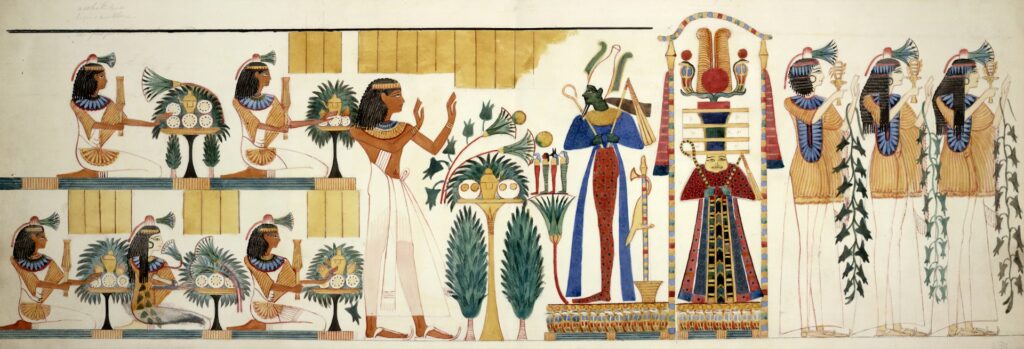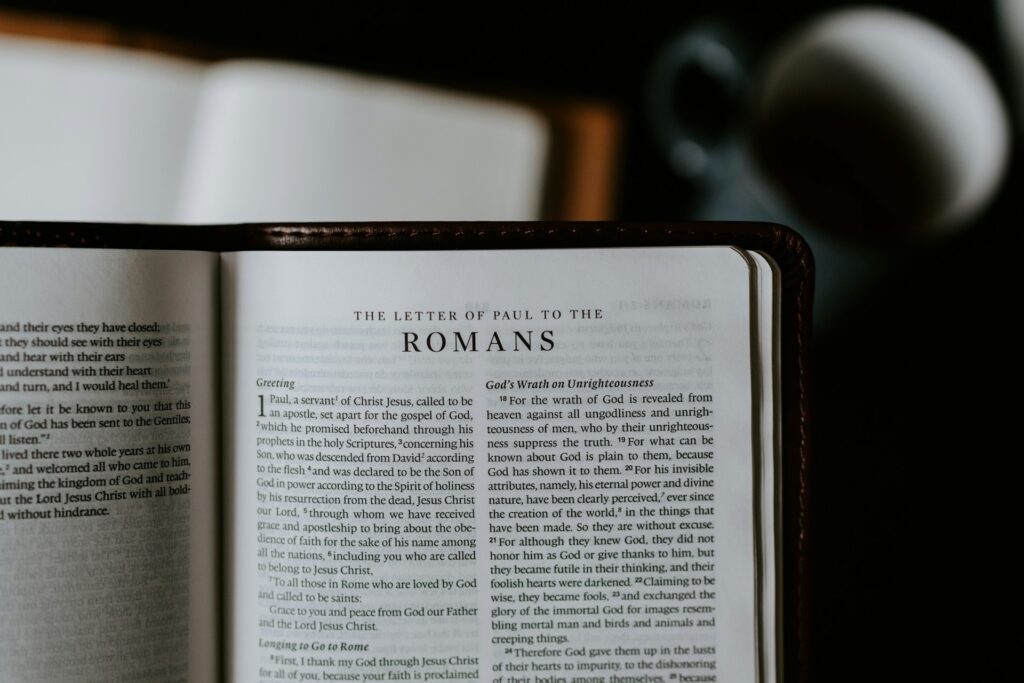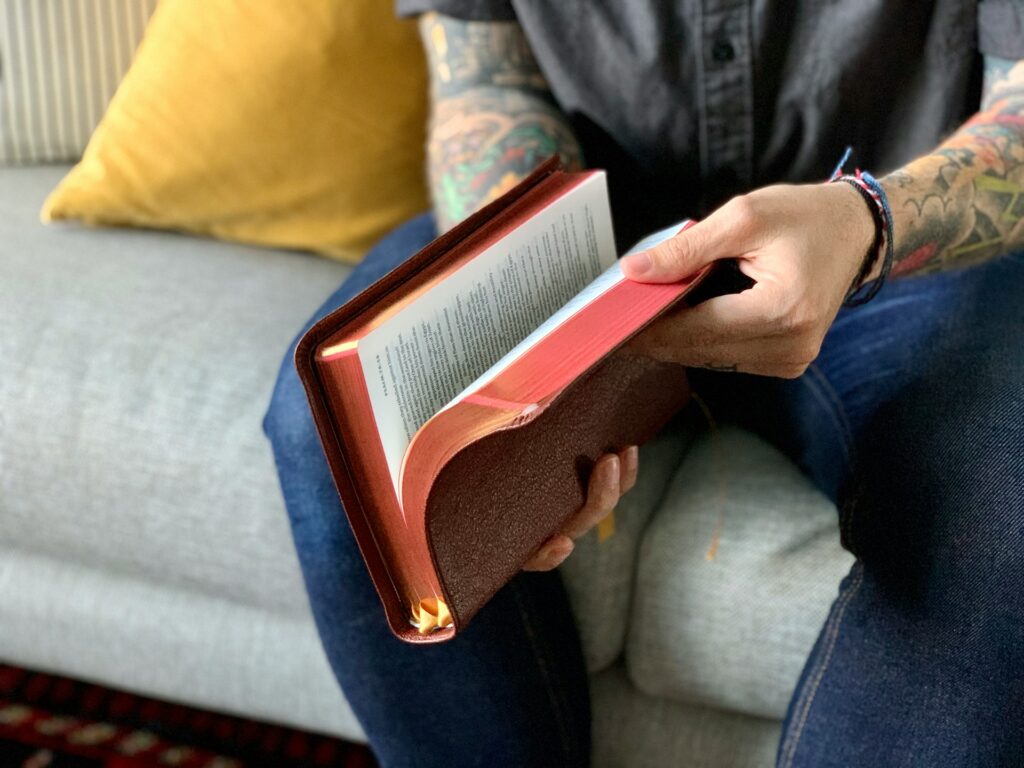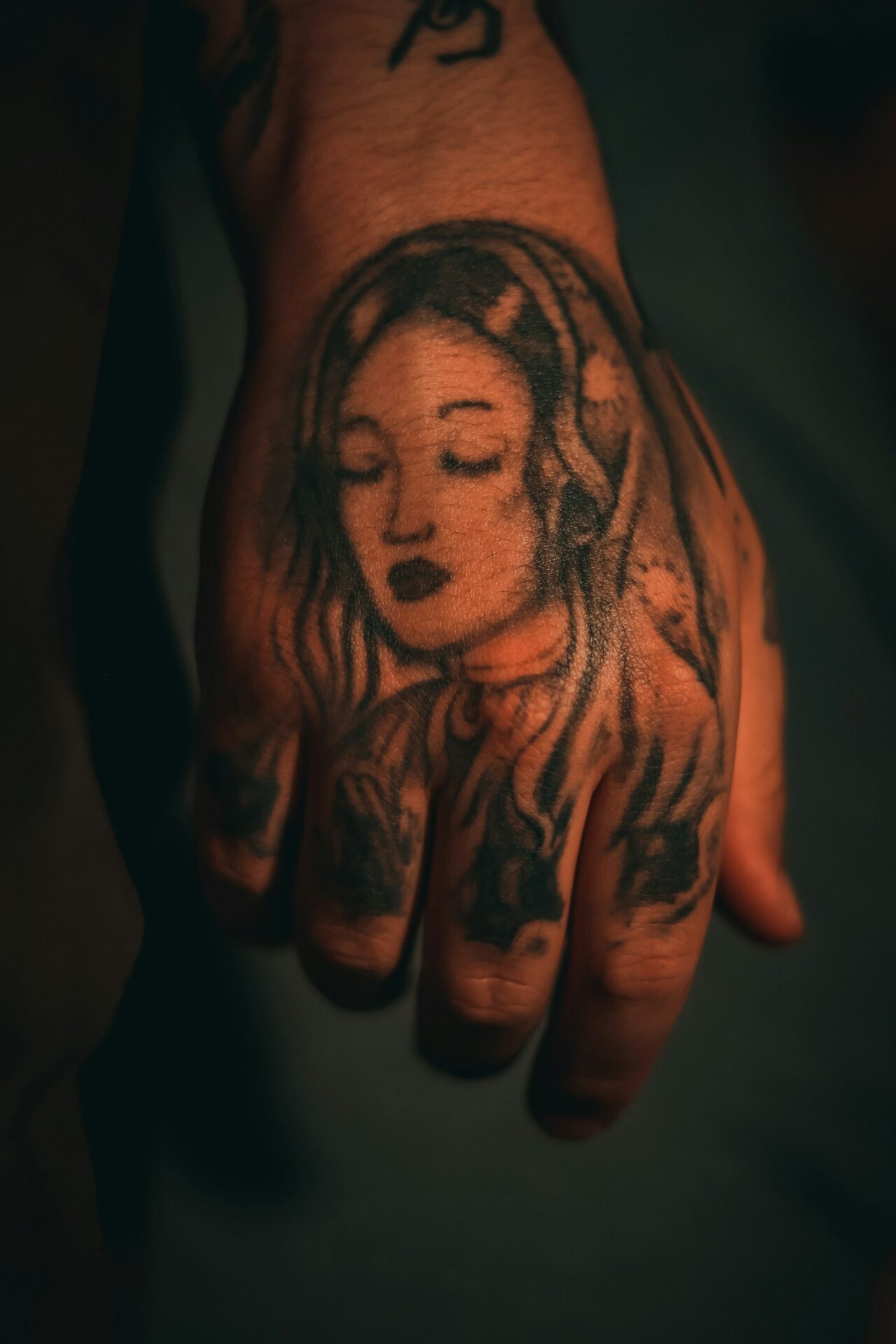What Does the Bible Say About Tattoos?
Table of Contents

Photo credit: Tim Wildsmith via Unsplash
Tattoos and the Bible. Do they get along? Well, both have a rich and varied history. Tattoos have actually been around much longer than ‘the Good Book’ and God’s people.
The Smithsonian Magazine writes that they’ve been seen on the bodies of Egyptian mummies dating back to 2,000 BCE (aka BC). But these aren’t even the oldest ones. The remains of a prehistoric man now known as ‘Ötzi the Iceman’, discovered in 1991, had tattoo patterns. Based on this tattoos were invented all the way back to 3,200 BCE.
It’s pretty wild how far tattoos have come since then. You can even design them now using AI. Here’s our guide on how to design tattoos with AI.
It’s no surprise then that the Bible has its own thoughts on marking your body. But what does the Holy Writ say about tattoos and how does it relate to modern religious beliefs?
The first mention of tattoos in the Bible takes place in the Old Testament. It’s a pretty well-known verse from Leviticus 19:28 that goes: “Do not cut your bodies for the dead or put tattoo marks on yourselves. I am the LORD.”
It’s pretty clear from this particular line that God wasn’t too keen on ink. However, we need to delve a little deeper into the context of this one verse. If you read the entire section you’ll see that this was one of many ‘laws’ that God was delivering to the people of Ancient Israel through Moses.
The section kicks off with some pretty decent and agreeable laws, such as:
-
- “Do not steal.”
-
- “Do not curse the deaf or put a stumbling block in front of the blind.”
-
- “Do not mate different kinds of animals.”
-
- “Do not hold back the wages of a hired worker overnight”
-
- “Do not defraud or rob your neighbour.”
There are many others that I won’t go into right now. There are also some laws in amongst these that are less applicable in modern-day life. These include:
-
- “Do not wear clothing woven of two kinds of material.”
-
- “Do not cut the hair at the sides of your head or clip off the edges of your beard.”
-
- “Do not eat any meat with the blood still in it.”
And that first one about tattoos. I think to better understand why some of these things that are innocent acts these days were outlawed back then, we have to understand what life was like for these Ancient Israelites.

Photo credit: Rod Long via Unsplash
There was a lot of violence back in that time, with conflicts amongst neighbouring nations. People were also struggling to survive harsh environments with a scarcity of food and water. As Iain Duguid writes, the Israelites had to endure an unforgiving wilderness even after they had survived enslavement in Egypt, plagues and a challenging escape over the Red Sea.
I mean, these were not prosperous times and people were desperate. Sometimes, that might’ve meant eating undercooked meat and suffering illness or worse. For others, they might’ve turned to foreign deities (such as Baal and Asherah) or spiritual practices that involved tattooing or shaving their hair. I think these words from God were designed to maintain people’s faiths back then, even with these seemingly impractical laws.
It’s why a lot of even the most devout followers of the Bible choose to accept that some of the messages and preachings were for a particular time. They may not be relevant for our current time or world.
Why Were Tattoos Outlawed in the Old Testament?
Tattoos especially were a very different kind of inking back in biblical times. Today we see them as works of art and expressions of our personality or own personal history and stories. But back when the Ancient Israelites were hearing the laws of God from Moses, tattoos had a very different meaning, often associated with the prohibition found in Leviticus 19:28, “You shall not make any cuts in your body for the dead or tattoo yourselves.”
Before Moses parted the Red Sea and led the Israelites to freedom, they were enslaved by the Egyptians. The Ancient Egyptians were particularly fond of branding their slaves to help identify any runaways. This ‘tattooing’ of slaves was also practiced in Ancient Greece, where troublesome slaves were branded with the Greek letter delta (first letter of doulos – ‘slave’ in Greek).
Tattoos weren’t just given to slaves or wrongdoers though. They were part of mourning rituals, in very select groups. They were also commonplace amongst Egyptian royalty.
As I mentioned at the beginning, Egyptian mummies dating back to 2,000 BCE have been found with dots and lines tattooed into their skin. The Egyptians with tattoos were often female. Their tattoos were also associated with religious worship. The American Research Center in Egypt has a great article about Ancient Egyptian tattoos.
The term ‘inscribed or engraved symbols’ in Leviticus 19:28 refers specifically to written marks made on the body, highlighting the cultural significance of body markings in ancient Egypt and Canaan.
So it’s not surprising that God would demand that all followers abstain from marking their bodies with tattoos, as they were either deemed a sign of enslavement or a sign of worshipping a foreign deity. Of course, this is very different to how tattoos are given today.
That’s exactly why we have to consider the context surrounding these passages in the Biblical texts and even other scriptures. That way we can better understand whether they are still applicable today.

Photo credit: British Library via Unsplash
What Does the Bible Say About Tattoos in the New Testament?
The Old Testament is just one half of the Bible. To really understand what the Bible says about tattoos, we have to also look at the New Testament and relevant bible verses. I’ve included some clear passages that could be associated with getting ink.
Additionally, the literal translation of certain Hebrew words in Leviticus 19:28 adds to the complexity of interpreting this verse and its application to modern tattooing practices.
Romans
I want to start with Paul’s letter to the Romans (Romans 10 in the New Testament, King James Version), particularly verse four to nine:
4 For Christ is the end of the law for righteousness to every one that believeth.
5 For Moses describeth the righteousness which is of the law, That the man which doeth those things shall live by them.
6 But the righteousness which is of faith speaketh on this wise, Say not in thine heart, Who shall ascend into heaven? (that is, to bring Christ down from above:)
7 Or, Who shall descend into the deep? (that is, to bring up Christ again from the dead.)
8 But what saith it? The word is nigh thee, even in thy mouth, and in thy heart: that is, the word of faith, which we preach;
9 That if thou shalt confess with thy mouth the Lord Jesus, and shalt believe in thine heart that God hath raised him from the dead, thou shalt be saved.
The Bible is of course open to interpretation, but I think it’s pretty clear here that Paul is saying Jesus will forgive and save all those who confess and believe in him. Even those who have gone against the commandments set out by Moses. Basically, Jesus is giving everyone a free pass when it comes to that pesky little commandment from the Old Testament about not marking your body with tattoos.
Potentially what’s happening here is an understanding of the changing times and practices in the world. And an acknowledgement that sometimes old laws become outdated in relation to modern-day behaviours and beliefs through faith in Jesus Christ.
Here are two more verses from Romans 12:1-2, which I think can be related to tattooing your body:
1 I beseech you therefore, brethren, by the mercies of God, that ye present your bodies a living sacrifice, holy, acceptable unto God, which is your reasonable service.
2 And be not conformed to this world: but be ye transformed by the renewing of your mind, that ye may prove what is that good, and acceptable, and perfect, will of God.
What the Bible is saying here about tattoos is that they should come from your own desires or understanding of what is right and acceptable in the eyes of God. It’s also warning people away from potentially marking their body, with tattoos or otherwise, based on social or peer pressures.
I think this is a really valuable message from the Bible about tattoos. I mean, if you’re going to permanently mark your body, it should be something that you want and feel right about. Not something that people or society have pressured you into getting. That’s just a recipe for regret, and some very expensive laser removal sessions in the future.

Photo credit: Kelly Sikkema via Unsplash
Corinthians
Moving onto Corinthians now, we see this softening of the Old Testament’s messaging occur again in 1 Corinthians 6:19–20.
19 What? know ye not that your body is the temple of the Holy Ghost which is in you, which ye have of God, and ye are not your own?
20 For ye are bought with a price: therefore glorify God in your body, and in your spirit, which are God’s.
Again, it’s open to your own interpretation. What I’m reading here is that the Bible is saying it’s okay to mark your body, so long as it’s in glorification to God. It’s saying to be considered when doing so, but if your markings are reflective of your faith and spirit, then there shouldn’t be an issue.
I think this is one of the most important passages in the Bible about tattoos. For devout believers in the Bible and its teachings, you have a pretty clear directive here that’s saying it’s okay to mark your body as long as you remember that your body is God’s temple.
Another passage from Corinthians has a similar sentiment. The following two verses are from 1 Corinthians 10:31-32:
31 Whether therefore ye eat, or drink, or whatsoever ye do, do all to the glory of God.
32 Give none offence, neither to the Jews, nor to the Gentiles, nor to the church of God.
There you have it. The Bible here is saying that whatever you choose to do to your body, make sure it honours God, yourself and the people around you. It’s best to avoid any tattoos that may cause offense to other cultures (though this should be a given whether you follow the Bible or not). But if your tattoo is in honour of God or yourself, and it doesn’t cause any offense to anyone, it’s okay to get one.
Remember, God’s Spirit dwells within you, so any action taken regarding your body should reflect this belief.
If you’d like to read more about the history of tattooing and the Bible, including any prohibitions and their reasons, I recommend this resource: The Biblical Prohibition Against Tattooing, by John Huehnergard and Harold Liebowitz. It delves into why tattoos were prohibited during Biblical times, including how Talmudic law only disallowed tattoos if they were “for the purpose of idolatry”, assuming this went against your religious beliefs.

Photo credit: Tim Wildsmith
Religious Tattoos are Very Common in Modern Times
Cultural shifts and more modern interpretations of what the Bible makes of tattoos, like what you’ve read above, have led to many Christians getting religious ink. In a lot of communities, religious tattoos are seen as beautiful expressions of someone’s faith. True Christians believe that through faith in Christ’s sacrifice, they receive God’s gift of eternal life, which is central to their beliefs and responsibilities as followers of Christ.
Baylor University actually did a study on religious tattoos back in 2023, looking at over 3,500 students of faith across 12 colleges. The study concluded that students with religious tattoos demonstrated a higher level of faith and would attend more religious ceremonies than those without. They also found that many Christians with ink would pray more frequently.
“Religious tattoos tend to be a vivid expression of strong faith and regular religious practice,” said Jerome R. Koch, Ph.D., professor of sociology at Texas Tech University.
What are Some Common or Accepted Religious Tattoos?
If you’re thinking about getting a tattoo to honour your religion and God, you might want to look at some of these example below. They’re just some tattoo ideas but definitely aren’t the limit of what you could get done to reflect your beliefs.
Additionally, consider how body piercings might also reflect your personal motivation and spiritual implications. If you’re unsure what to do beforehand, read our guide on how to prepare for a tattoo.
1. Jesus
Jesus Christ depictions on bodies are pretty common around the world. You can play with the design here and choose to go with a face or full-body tattoo. There are a number of different tattoo styles to pick, so it’s really up to your inner guide.
2. Sacred Heart
This is a well-known symbol of Jesus’ sacrifice for all humanity. A typical depiction of this symbol is a red heart, encircling thorns and a great, radiant light. It sounds impactful and it really is something to admire and respect on someone’s skin.
3. Holy Spirit
Getting a tattoo of the Holy Spirt gives you all sorts of creative licence. This is a great option if you really want to draw upon your own internal faith and beliefs. There are so many depictions of the Holy Spirit, but don’t be afraid to make your tattoo in your own image.

Photo credit: Bruno Guerrero via Unsplash
4. Virgin Mary
Another typical tattoo for followers of the Bible, the Virgin Mary should honour the woman’s power and sacrifice. She is a great symbol of faith and would be a very good option for expressing your devotion.
5. Rosary Beads
These are a no-brainer. A typical tattoo placement for rosary beads is around someone’s forearm, depicting how you would hold them when in prayer. You could even combine the beads with a tattoo of the cross or crucifix. Speaking of…
6. The Crucifix
Bearing the figure of Jesus, the crucifix is a powerful and inspiring symbol of religious faith. There are some truly beautiful crucifix tattoos out in the world. The crucifix emphasises Jesus’ sacrifice and reminds us of the power of redemption and forgiveness.
Some Final Thoughts on the Bible and How Tattoos Can Glorify God
What does the Bible say about tattoos and sinning? Is getting a tattoo a sin?
Everything we’ve taken away from the Bible here tells us that no, it’s not a sin to get a tattoo. While it might have been outlawed for the Ancient Israelites by God in the Old Testament, this law was basically eradicated by the teachings of Jesus and his disciples in the New Testament. However, it is important to consider how your actions are viewed in God’s sight.
There are of course some caveats here that we can see in the New Testament. And these are pretty valuable considerations to keep in mind if you are going to get a tattoo.
- Tattoo your body only if it comes from your desire or wants. Not from the wants of others, such as friends, family or general society.
- Make sure your tattoo honours yourself and God. And that it doesn’t insult anyone.
If you abide by those two practices, there is no reason why getting a tattoo will be sinful. Your body can ultimately become an expression of your religious beliefs and love for God. And this is something that even Christianity tells us is a great and true thing to do. Remember, true adornment should come from the hidden person of the heart.
If you’re a devout Christian and are worried about upsetting your religious beliefs by getting a tattoo, I recommend taking some time to pray about it. I was raised Catholic and spent a lot of my childhood studying the Bible. One of the biggest lessons I took away from this was that so much of the Good Book is up to your interpretation. It is also important to cultivate a gentle and quiet spirit, which is precious in God’s sight.
If the question is still, “What does the Bible say about tattoos?”, truth is, the Holy Writ doesn’t have a clear answer for us. There are certain verses, which I’ve covered earlier, that could be linked to marking your body. However, it seems that in the case of getting inked, you’ll need to take what you can from the Bible and use your own established beliefs to guide you.
So why not spend a little time doing some self-reflection on whether you should get a tattoo? You never know, God may have an answer for you. Or you may very well find the answer yourself through spiritual worship.
Are you ready to start designing a religious tattoo? If you use our free AI tattoo generator you can get an idea of what design might work for your tattoo. All you need to do is give our tool some prompts (e.g. an artistic crucifix), select colour, style and other customisations, then generate your tattoo.